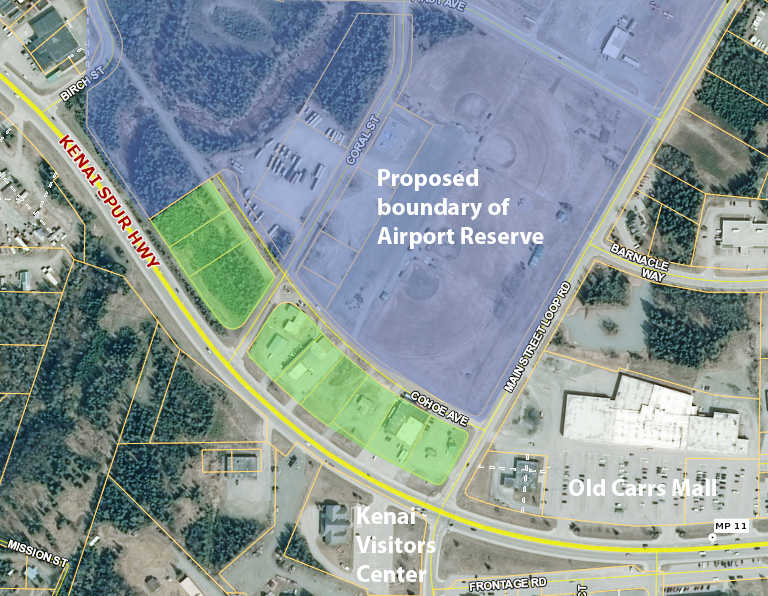Editor’s note: This story has been changed to include the date of the Kenai City Council’s hearing and vote on the boundary move.
The Kenai Planning and Zoning commission unanimously voted Wednesday to move the boundary of Kenai’s airport reserve — an area in which properties are dedicated to airport use — north from the Kenai Spur Highway, freeing seven Spur-fronting lots for sale.
The boundary move was suggested by a unanimous vote of Kenai airport commissioners on July 14. The Kenai City Council will hold a public hearing and vote on the move at their Sept. 21 meeting.
Of the nine lots that would leave the airport reserve, seven are city-owned and two are privately owned. Four are vacant and five are developed. The two developed lots in private hands represent recent sales of airport-dedicated city land to private ownership. One, sold in 2013, is the location of the Bargain Basement thrift store, and the other, on the corner of the Spur and Main Street Loop, is the former site of the Golden Eagle Tobacco stand, which entrepreneur Ronald Smith bought in April 2016.
Though property inside the airport reserve is legally dedicated to aviation, exceptions such as these exist. The three other developed lots in the Spur-bordering strip also contain non-aviation businesses — the Paisley Boutique furnishings and gift store, the Big Dipper Car wash, Summit Cleaners dry cleaning, a daycare and a hair salon. Unlike Bargain Basement and the former Golden Eagle stand, these privately owned business buildings sit on city-owned land and their owners pay rent on annual leases to the city.
Once the boundary is moved, the city will take offers for the sale of these properties, as outlined in an ordinance introduced by council members Henry Knackstedt and Brian Gabriel, which passed on August 3.
Don Moffis is managing the property of the Big Dipper Car Wash on behalf of Patrick and Mary Doyle, whom he said have held a lease on the land for about 30 years.
Big Dipper sits in the middle of the Spur-side strip, in a building also occupied by the salon, a Girl Scout clubhouse and the office of Busy Bee Cleaning Services, whose owners sublease from the Doyles.
Moffis said he was glad for the opportunity to buy the land, but the sales negotiation allowed in Knackstedt and Gabriel’s ordinance is “where it all falls into a big old crack.”
That ordinance sets a minimum price for the properties at 125 percent of the land’s value. The value of the Big Dipper land, according to a city property appraisal done in February 2015, is $128,315 — making the 25 percent increase worth an extra $32,078, though the ordinance requires a new assessment before the sale. Moffis said this was contrary to the expectation the Doyles had when they signed the lease — that they’d be able to buy the land for its assessed value.
“These property owners have been good tenants and working with the city for years, and now the city’s got them in the palm of their hands, so they’re going to hammer them for an extra 25 percent of what the property’s worth,” Moffis said.
Moffis intends to buy the land on behalf of the Doyles so the business — building and land — can be sold. Owning the land along with the building, he said, would make the property more palatable to potential buyers.
Geoffrey Graves owns Summit Cleaners dry cleaning and the daycare, both on a city-owned property on the strip’s west end. He hasn’t decided whether or not he’ll try to buy the land beneath his businesses, although he’s also dealt with the problem of prospective buyers being turned off by the property’s lease.
“I personally wrote this building and the one behind it off as a loss because I wouldn’t be able to sell them,” Graves said.
Graves, who has leased the land for 15 years, said he is considering remodeling on Summit Cleaners but has been hesitant to make the investment without a realistic sales prospect.
“I’m 70 years old, and I can’t see putting any more money into the building,” Graves said. “I won’t be getting 20 more years of use from it. But now I could remodel it so my sons or whoever buys it can get some value from it.”
At Wednesday’s planning and zoning meeting, the boundary movement was non-controversial.
Planning and zoning commissioner Kenneth Peterson asked Knackstedt, the planning and zoning commission’s non-voting city council liaison, and a former airport commissioner, for his general opinion of the boundary move.
The boundary move is a recommendation of the Airport Master Plan — a set of development rules currently being revised by the airport commission. Knackstedt was the chair of the airport commission in 2010, when he said revision of the Airport master plan began. He said the airport commission had been in agreement since the beginning about the boundary move.
“Going through the master plan, it has been the intent for some time to do that (move the boundary),” Knackstedt said. “It makes sense. In discussions we’ve had before, these lots along the Spur Highway are not needed for airport uses. In fact, they have other uses. And they do exit off the the highway, so it does seem appropriate to let them be outside the reserve, so they’re no longer under that umbrella.”
Overall, Graves believes rolling the airport boundary back will help Kenai’s business environment on the west side of town.
“I think they would have ended up with a dead area over here without it,” he said.
Reach Ben Boettger at ben.boettger@peninsulaclarion.com.

